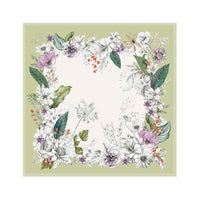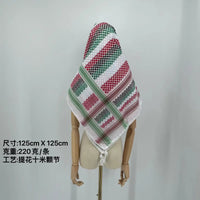Introduction: Why is bamboo fabric becoming increasingly popular?
Bamboo is a sustainable resource that grows quickly and requires no pesticides, earning it the nickname "green fiber." Not only is it soft and skin-friendly, it also boasts natural antibacterial and moisture-wicking properties, making it suitable for those with sensitive skin and those who are environmentally conscious.
In recent years, bamboo fiber has been widely used in clothing, home textiles, and maternity and baby products. However, with so many different bamboo fabrics available, how can you choose? This article will detail 15 popular bamboo fabrics to help you find the perfect one for you!
Key Advantages of Bamboo Fabric
✅ Environmentally Friendly: Bamboo grows quickly, is biodegradable, and uses less water than cotton.
✅ Breathable and Moisture-Wicking: Ideal for summer and athletic wear.
✅ Naturally Antibacterial: Reduces odor, making it suitable for underwear and socks.
✅ Soft and Comfortable: Comparable to silk, suitable for sensitive skin.
A comprehensive analysis of 15 types of bamboo fabrics
(1) Bamboo fiber (natural bamboo fiber)
- Process: Natural fiber extracted directly from bamboo, similar to the processing method of linen.
- Advantages: 100% natural, excellent breathability, strong antibacterial properties.
- Disadvantages: Hard, easy to wrinkle, expensive.
- Application: Summer shirts, eco-friendly bags.
- Cleaning: Hand wash or gentle machine wash, avoid exposure to the sun.
(2) Bamboo pulp fiber (regenerated bamboo fiber/viscose bamboo fiber)
- Process: Chemically dissolve bamboo to make viscose fiber, similar to modal.
- Advantages: Soft and smooth, moderately priced, widely used in home textiles.
- Disadvantages: The production process involves chemical reagents, which is not environmentally friendly.
- Application: T-shirts, sheets, towels.
- Cleaning: Water temperature below 30°C, avoid drying.
(3) Bamboo charcoal fiber
- Process: Bamboo charcoal powder is integrated into the fiber to enhance adsorption capacity. - Advantages: Deodorizing, moisture-absorbing, anti-static, suitable for sportswear.
- Disadvantages: The color is darker, and the adsorption capacity decreases with long-term use.
- Applicable to: socks, underwear, yoga pants.
- Cleaning: Avoid using softeners to avoid clogging the fiber pores.
(4) Bamboo-Cotton Blend
- Process: Blend of bamboo fiber and cotton (common ratio 55% bamboo + 45% cotton).
- Advantages: Combining the durability of cotton and the breathability of bamboo, it is cost-effective and suitable for daily wear.
- Disadvantages: The antibacterial property is slightly weaker than that of pure bamboo fiber, and it is easy to pill after multiple washings.
- Applicable to: T-shirts, pajamas, baby clothes.
- Cleaning: Machine wash in cold water, wash on the reverse side to reduce pilling.
(5) Bamboo-Linen Blend
- Process: Blend of bamboo fiber and linen to enhance the crispness.
- Advantages: Naturally wrinkle-resistant and highly breathable, suitable for summer suits and shirts.
- Disadvantages: Rough feel, sensitive skin may feel itchy.
- Suitable for: business casual wear, curtains, tablecloths.
- Cleaning: Hand wash or gentle machine wash, lay flat to dry to prevent deformation.
(6) Bamboo-Tencel
- Process: Blended bamboo fiber and lyocell (Tencel), using environmentally friendly solvent spinning technology.
- Advantages: Glossiness close to silk, good drape, strong moisture absorption.
- Disadvantages: High price, strength decreases after getting wet, need to be carefully cared for.
- Suitable for: high-end dresses, four-piece bedding sets.
- Cleaning: Hand wash in cold water, avoid wringing, and dry in the shade.
(7) Bamboo Silk
- Process: Blended bamboo fiber and mulberry silk (usually 70% bamboo + 30% silk).
- Advantages: Luxurious luster, excellent skin-friendliness, suitable for sensitive skin.
- Disadvantages: Delicate and difficult to care for, easy to snag, expensive.
- Applicable to: dresses, scarves, high-end underwear.
- Cleaning: Professional dry cleaning or hand washing in cold water, do not expose to direct sunlight.
(8) Bamboo Coolmax Blend
- Process: Blend of bamboo fiber and Coolmax (quick-drying polyester fiber).
- Advantages: Quick perspiration, suitable for high-intensity exercise, more environmentally friendly than pure polyester.
- Disadvantages: Contains synthetic fibers, slightly less breathable than pure bamboo.
- Applicable to: sports bras, hiking socks, fitness clothes.
- Cleaning: Machine wash at low temperature to avoid softener clogging the fibers.
(9) Bamboo Terry Cloth
- Process: Bamboo fiber woven into a terry structure, similar to towel material.
- Advantages: Super absorbent, soft and non-shedding, naturally antibacterial.
- Disadvantages: The terry loops tend to become loose after long-term use and need to be replaced regularly.
- Application: Bathrobes, baby bibs, cleansing towels.
- Cleaning: Avoid high temperatures and bleach, and hang to dry.
(10) Bamboo Fleece
- Process: Bamboo fibers are made into a velvet surface through a raising process.
- Advantages: Warm and lightweight, more breathable and environmentally friendly than polyester fleece.
- Disadvantages: Static electricity is generated, and the velvet surface is prone to dust.
- Application: Home clothes, blankets, winter inner wear.
- Cleaning: Machine wash on a gentle cycle, tumble dry at low temperature to remove static electricity.
(11) Bamboo Gauze
- Process: Bamboo fibers are interwoven into a loose gauze structure.
- Advantages: Super breathable, becomes softer with each wash, and is suitable for layering.
- Disadvantages: Initially feels hard and has average durability.
- Application: Summer swaddling blankets, postpartum clothes, air-conditioning quilts.
- Cleaning: Machine wash in cold water, air dry to prevent shrinkage.
(12) Bamboo Denim
- Process: Bamboo fiber and cotton blended to imitate denim texture.
- Advantages: Softer than traditional denim, reduces friction on the skin.
- Disadvantages: Poor elasticity, easy to fade after multiple washes.
- Application: Casual jeans, overalls.
- Cleaning: Machine wash inside out, soak in salt water to fix the color.
(13) Bamboo Jersey
- Process: Elastic knitted fabric made of bamboo fiber.
- Advantages: Good elasticity, close-fitting without being tight, suitable for curve cutting.
- Disadvantages: Easy to deform, avoid hanging for storage.
- Application: Yoga pants, base shirts, home socks.
- Cleaning: Lay flat to dry, avoid high temperature in the dryer.
(14) Bamboo Nonwoven
- Process: Made from bamboo fibers that are pressed and not woven.
- Advantages: Disposable, environmentally friendly, and biodegradable.
- Disadvantages: Low strength, not reusable.
- Applications: Facial mask paper, medical dressings, and eco-friendly shopping bags.
- Cleaning: Not washable, discarded or composted after use.
(15) Bamboo Fiber Fill
- Process: Bamboo fibers are fluffed and used as filling.
- Advantages: A down alternative, lightweight, warm, and dust mite-proof.
- Disadvantages: Poor resilience after long-term compression.
- Applications: Pillows, winter quilts, and doll fillings.
- Cleaning: Machine wash on the gentle cycle, and pat to restore the fluffiness.
How to choose the most suitable bamboo fabric?
- Seeking natural and eco-friendly fabrics → Bamboo Fiber
- Wanting softness and skin-friendly fabrics → Bamboo Pulp Fiber or Bamboo Tencel
- Needing moisture-wicking properties → Bamboo Charcoal Fiber or Bamboo Coolmax blend
- Budget-Friendly → Bamboo Cotton Blend
Interactive Session: Which bamboo fabric is your favorite?
🔹 Vote:
- Bamboo Fiber (Natural)
- Bamboo Pulp Fiber (Value)
- Bamboo Charcoal Fiber (Functional)
- Other (Share in the comments!)
Conclusion
There are many different types of bamboo fabrics. Bamboo pulp fiber is best for everyday household use. Bamboo Fiber is more eco-friendly but more expensive. Bamboo Charcoal Fiber is suitable for sports enthusiasts. Choose the right fabric based on your needs and clean it properly to extend its life!
Have you used bamboo fiber products? What were your experiences?





















